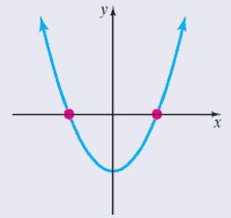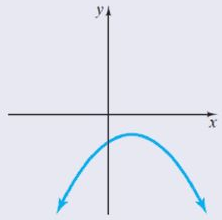
Find the nature of the roots of the following quadratic equation. If the real roots exist, find them.
$2{x^2} - 3x + 5 = 0$
A) x = 0 and x = -2
B) x = 3, x = -6
C) No real root
D) None of these
Answer
578.4k+ views
Hint: The nature of the roots depends on the value of the discriminant of the quadratic equation.
$a{x^2} + bx + c = 0$, where $a \ne 0$
Find the Discriminant, $D = {b^2} - 4ac$ , of the given quadratic equation, and check the sign (i.e. positive or negative or zero) to know if there are two solutions or one solution or no solution.
Complete step-by-step answer:
Step 1: Given the quadratic equation:
$2{x^2} - 3x + 5 = 0$
On comparing with standard quadratic equation: $a{x^2} + bx + c = 0$, where $a \ne 0$
a = 2, b = -3, c = 5
Step 2: Find discriminant:
$D = {b^2} - 4ac$
$D = {\left( { - 3} \right)^2} - 4 \times 2 \times 5$
$
\Rightarrow {\text{ }} = 9 - 40 \\
\Rightarrow {\text{ }} = - 31 \\
$
Step 3: Check the sign of discriminant:
$D < 0$
Hence, the roots are imaginary.
Final answer: The roots of $2{x^2} - 3x + 5 = 0$ are not real. Thus the correct option is (C).
Additional Information:
Roots of the quadratic equation is given by:
Quadratic equation: $a{x^2} + bx + c = 0$, where $a \ne 0$
Roots: \[x = \dfrac{{ - b \pm \sqrt D }}{{2a}}\]
The imaginary roots of the given quadratic equation are:
$2{x^2} - 3x + 5 = 0$
D = -31
\[x = \dfrac{{ - b \pm \sqrt D }}{{2a}}\]
$
{\text{ }}x = \dfrac{{ - \left( { - 3} \right) \pm \sqrt {\left( { - 31} \right)} }}{{2\left( 2 \right)}} \\
\Rightarrow {\text{ }} = \dfrac{{3 \pm {\text{i}}\sqrt {31} }}{4} \\
$
Note: For quadratic equation: $a{x^2} + bx + c = 0$, where $a \ne 0$
Let $y = f\left( x \right) = a{x^2} + bx + c = 0$
Discriminant, $D = {b^2} - 4ac$
A discriminant of zero indicates that the quadratic has a repeated real number solution.
i.e. $D = 0$ , roots are real and equal.
$ \Rightarrow {b^2} - 4ac = 0$

A positive discriminant indicates that the quadratic has two distinct real number solutions.
i.e. $D > 0$ , roots are real and unequal.
$ \Rightarrow {b^2} - 4ac > 0$

A negative discriminant indicates that neither of the solutions is real numbers.
And if D < 0, as in the case of the given question, roots are imaginary.
$ \Rightarrow {b^2} - 4ac < 0$

$a{x^2} + bx + c = 0$, where $a \ne 0$
Find the Discriminant, $D = {b^2} - 4ac$ , of the given quadratic equation, and check the sign (i.e. positive or negative or zero) to know if there are two solutions or one solution or no solution.
Complete step-by-step answer:
Step 1: Given the quadratic equation:
$2{x^2} - 3x + 5 = 0$
On comparing with standard quadratic equation: $a{x^2} + bx + c = 0$, where $a \ne 0$
a = 2, b = -3, c = 5
Step 2: Find discriminant:
$D = {b^2} - 4ac$
$D = {\left( { - 3} \right)^2} - 4 \times 2 \times 5$
$
\Rightarrow {\text{ }} = 9 - 40 \\
\Rightarrow {\text{ }} = - 31 \\
$
Step 3: Check the sign of discriminant:
$D < 0$
Hence, the roots are imaginary.
Final answer: The roots of $2{x^2} - 3x + 5 = 0$ are not real. Thus the correct option is (C).
Additional Information:
Roots of the quadratic equation is given by:
Quadratic equation: $a{x^2} + bx + c = 0$, where $a \ne 0$
Roots: \[x = \dfrac{{ - b \pm \sqrt D }}{{2a}}\]
The imaginary roots of the given quadratic equation are:
$2{x^2} - 3x + 5 = 0$
D = -31
\[x = \dfrac{{ - b \pm \sqrt D }}{{2a}}\]
$
{\text{ }}x = \dfrac{{ - \left( { - 3} \right) \pm \sqrt {\left( { - 31} \right)} }}{{2\left( 2 \right)}} \\
\Rightarrow {\text{ }} = \dfrac{{3 \pm {\text{i}}\sqrt {31} }}{4} \\
$
Note: For quadratic equation: $a{x^2} + bx + c = 0$, where $a \ne 0$
Let $y = f\left( x \right) = a{x^2} + bx + c = 0$
Discriminant, $D = {b^2} - 4ac$
A discriminant of zero indicates that the quadratic has a repeated real number solution.
i.e. $D = 0$ , roots are real and equal.
$ \Rightarrow {b^2} - 4ac = 0$

A positive discriminant indicates that the quadratic has two distinct real number solutions.
i.e. $D > 0$ , roots are real and unequal.
$ \Rightarrow {b^2} - 4ac > 0$

A negative discriminant indicates that neither of the solutions is real numbers.
And if D < 0, as in the case of the given question, roots are imaginary.
$ \Rightarrow {b^2} - 4ac < 0$

Recently Updated Pages
Two men on either side of the cliff 90m height observe class 10 maths CBSE

What happens to glucose which enters nephron along class 10 biology CBSE

Cutting of the Chinese melon means A The business and class 10 social science CBSE

Write a dialogue with at least ten utterances between class 10 english CBSE

Show an aquatic food chain using the following organisms class 10 biology CBSE

A circle is inscribed in an equilateral triangle and class 10 maths CBSE

Trending doubts
Why is there a time difference of about 5 hours between class 10 social science CBSE

Write a letter to the principal requesting him to grant class 10 english CBSE

What is the median of the first 10 natural numbers class 10 maths CBSE

The Equation xxx + 2 is Satisfied when x is Equal to Class 10 Maths

Which of the following does not have a fundamental class 10 physics CBSE

State and prove converse of BPT Basic Proportionality class 10 maths CBSE




